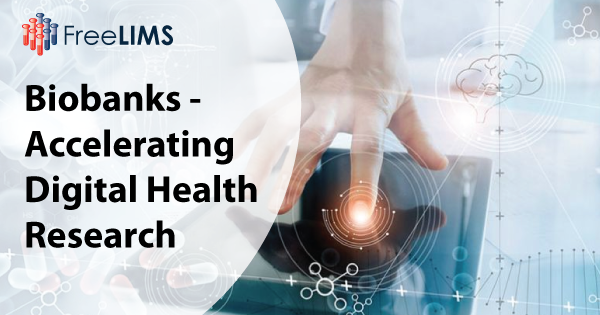The global burden of diseases has shifted from communicable to noncommunicable diseases, and so has the focus of medical research. Around 41 million people die each year due to noncommunicable diseases, which is equivalent to 74% of all deaths worldwide. Rising cases of chronic and difficult-to-treat conditions such as cancer, diabetes, Alzheimer’s, and cardiovascular diseases have catalyzed medical advances in areas such as genomic and other -omic-driven research. This, in turn, has accelerated the demand for complex and diversified biospecimens and disease-specific biomarkers to meet the emerging needs of the scientific community. At the same time, there has been an all-round adoption and integration of technology and informatics in healthcare research. In this blog, we delineate the benefits of biobanking in scaling the value chain of digital health research.
What is Digital Health Research?
Digital health is an umbrella term that encompasses different kinds of digital technologies that have been adopted to enhance healthcare delivery, such as health information technology (IT), telehealth, mHealth, telemedicine, and personalized medicine.
On the other hand, digital healthcare research refers to the use of digital health tools such as software and mobile apps to enhance clinical research. Such tools enhance the efficiency in medical research and hence may lead to better medical outcomes as drugs are introduced sooner to the market.
For example, electronic consent forms eliminate time-consuming clinical paperwork and are easy to access from remote locations. The use of phones and tablets makes it easy to collect personal health information that is useful for developing personalized medicine.
Biobanks – A Key Driver for Digital Health Research
Digital health research is a progressive process that allows for the continuous accumulation, processing, and dissemination of relevant clinical data and information. The number of clinical studies has increased dramatically in the past couple of years. Biobanks help clinicians leverage digital health technologies to keep up with the increasing clinical research demands. At the same time, digital health provides a technological platform that allows clinical researchers to exploit the full potential of modern biobanking. Digital tools provide a competitive advantage to biobanks. Here is how:
1. Track Biospecimens Through the Sample Lifecycle
Digital tools allow biobanks to track biospecimens from collection to disposal and everything in between. Furthermore, digital technologies tools also collect and store phenotypic and demographic information related to biospecimens that are useful drivers of precision medicine.
2. Leverage Paperless Biobanking
Digitization eliminates paperwork in biobanking processes and hence reduces errors and increases efficiency. It allows for online consent collection, evaluation, and review of data. It also provides an avenue for virtual collaboration and therefore, faster turnaround times, improved decision-making, and increased productivity.
3. Integrate Disparate Data Sources
Digitalization enables biobanks to easily integrate biospecimen-derived data (such as -omics) and a wide spectrum of accumulated phenotypic information obtained from various digital health sources, such as Electronic Health Records (EHRs) and Electronic Medical Records (EMRs). The data can be collected and integrated over time to facilitate clinical research. Digital health technologies and tools offer several benefits, such as real-time analytics, customizable reporting, and virtual collaboration.
Why is Biorepository Software Important?
A biorepository management system enables biobanks to automate their processes for greater efficiency and productivity. A biobanking LIMS tracks biospecimens throughout their lifecycle and manages their associated metadata. A highly secure biorepository management system ensures that data integrity is maintained while supporting compliance with regulatory requirements. A cloud-based biorepository software provides an avenue for real-time access to biospecimen data remotely. Moreover, it facilitates easy sharing and collaboration between researchers.
Conclusion
Modern biobanks are highly specialized and may be specific to a population, disease, or geographical location. With digital tools, biobanks can broaden their scope and expand their reach to diverse biospecimen donors present at disparate locations. With digitization, biobanks can achieve zero error and greater efficiency, track samples and metadata, as well as ensure seamless interoperability with other sources of donor data. Automation through a biorepository management system boosts the efficiency and productivity of biobanks. At the same time, LIMS-enabled biobanks enable clinical researchers to achieve digital health research goals with ease.


